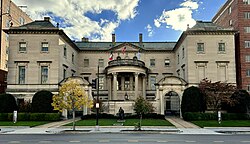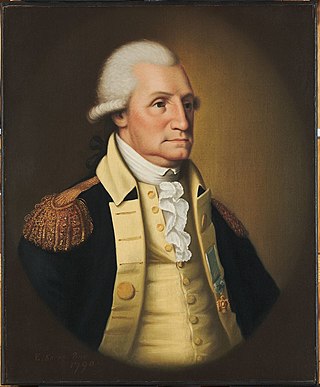
The Society of the Cincinnati is a fraternal, hereditary society founded in 1783 to commemorate the American Revolutionary War that saw the creation of the United States. Membership is largely restricted to descendants of military officers who served in the Continental Army.

Ford's Theatre is a theater located in Washington, D.C., which opened in August 1863. The theater is infamous for being the site of the assassination of Abraham Lincoln. On the night of April 14, 1865, John Wilkes Booth entered the theater box where Lincoln and his wife were watching a performance of Our American Cousin, slipped the single-shot, 5.87-inch derringer from his pocket and fired at Lincoln's head. After being shot, the fatally wounded Lincoln was carried across the street to the Petersen House, where he died the next morning.

Fraunces Tavern is a museum and restaurant in New York City, situated at 54 Pearl Street at the corner of Broad Street in the Financial District of Lower Manhattan. The location played a prominent role in history before, during, and after the American Revolution. At various points in its history, Fraunces Tavern served as a headquarters for George Washington, a venue for peace negotiations with the British, and housing federal offices in the Early Republic.

Baldwin the Eagle, an anthropomorphized bald eagle, is the mascot of the Boston College Eagles.

The American Civil War Museum is a multi-site museum in the Greater Richmond Region of central Virginia, dedicated to the history of the American Civil War. The museum operates three sites: The White House of the Confederacy, American Civil War Museum at Historic Tredegar in Richmond, and American Civil War Museum at Appomattox. It maintains a comprehensive collection of artifacts, manuscripts, Confederate books and pamphlets, and photographs.

The Lightner Museum is a museum of antiques, mostly American Gilded Age pieces, housed within the historic Hotel Alcazar building in downtown St. Augustine. This 1887 Spanish Renaissance Revival style building is listed on the National Register of Historic Places.
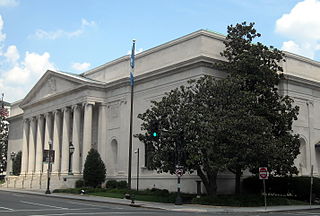
DAR Constitution Hall is a concert hall located at 1776 D Street NW, near the White House in Washington, D.C. It was built in 1929 by the Daughters of the American Revolution to house its annual convention when membership delegations outgrew Memorial Continental Hall. Later, the two buildings were connected by a third structure housing the DAR Museum, administrative offices, and genealogical library. DAR Constitution Hall is still owned and operated by the National Society of Daughters of the American Revolution. It was designated a National Historic Landmark in 1985. It has been a major cultural center of the city since its construction, and houses its largest auditorium.

The National Society of The Colonial Dames of America (NSCDA) is an American organization composed of women who are descended from an ancestor "who came to reside in an American Colony before 1776, and whose services were rendered during the Colonial Period." The organization has 44 corporate societies. The national headquarters is Dumbarton House in Georgetown, Washington, D.C. The executive director since September 2021 is Carol Cadou.

Larz Anderson was an American diplomat and bon vivant. He served as second secretary at the United States Legation to the Court of St James's, London; as first secretary and later chargé d'affaires at the United States Embassy in Rome; as United States Minister to Belgium; and then briefly as the Ambassador to Japan. He also unsuccessfully sought appointment as Ambassador to Italy.

Larz Anderson Auto Museum is located in the Anderson Carriage House on the grounds of Larz Anderson Park in Brookline, Massachusetts and is the oldest collection of motorcars in the United States.
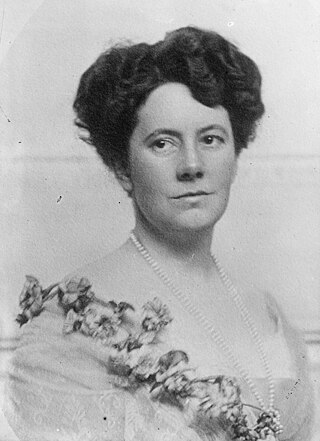
Isabel Anderson, née Isabel Weld Perkins, was a Boston heiress, author, and society hostess who left a legacy to the public that includes a park and two museums.

William Fletcher Weld was an American shipping magnate during the Golden Age of Sail and a member of the prominent Weld family. He later invested in railroads and real estate. Weld multiplied his family's fortune into a huge legacy for his descendants and the public.

Larz Anderson Park is a wooded, landscaped, and waterscaped 64-acre (26 ha) parkland in Brookline, Massachusetts that is listed on the National Register of Historic Places. The southwest corner of the park is in Boston. The park contains playing fields, picnic areas, gardens, waterways, an ice skating rink, and two sites of special interest:

Nicholas Longworth Anderson was a United States Army officer who served in the American Civil War as Colonel of the 6th Ohio Volunteer Infantry. After the Civil War, he was nominated and confirmed for appointment to the brevet grades of brigadier general and major general of volunteers.

Perkins Manor is a historic building in Contoocook, New Hampshire. It is the birthplace of Commodore George H. Perkins and later served as one of several homes of his daughter Isabel Weld Perkins and her husband Larz Anderson.
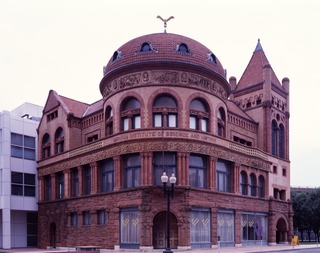
The Barnum Museum is a museum at 820 Main Street in Bridgeport, Connecticut, United States. It has an extensive collection related to P. T. Barnum and the history of Bridgeport, and is housed in a historic building on the National Register of Historic Places.
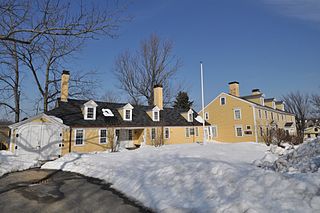
The American Independence Museum is a historic house museum located in Exeter, New Hampshire. Its 1-acre (0.40 ha) campus includes two buildings: the Ladd-Gilman House, a registered National Historic Landmark built in 1721 by Nathaniel Ladd, and the Folsom Tavern, listed on the New Hampshire State Register of Historic Places and built in 1775 by Colonel Samuel Folsom. The museum was opened in 1991 after a rare copy of the Declaration of Independence known as a Dunlap Broadside was found in the Ladd-Gilman house, 200 years after its arrival in Exeter. It is the centerpiece of the museum’s collection. The museum’s mission is “Connecting America’s Revolutionary past with the present.”

The Alibi Club is a traditional private club in Washington, D.C. Its members consist of the Washington elite, including presidents, senators, and diplomats, among other prominent figures.
Stephen T. Moskey is an American author and editor specializing in scholarly works on cultural history and American biography. He has occasionally published under the name Skip Moskey.
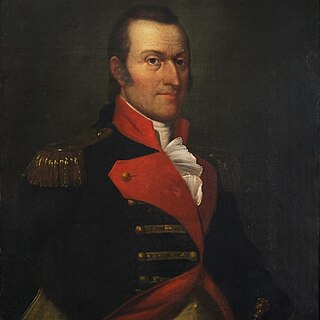
Richard Clough Anderson Sr. was an American lawyer, soldier, politician, and surveyor from Virginia.
